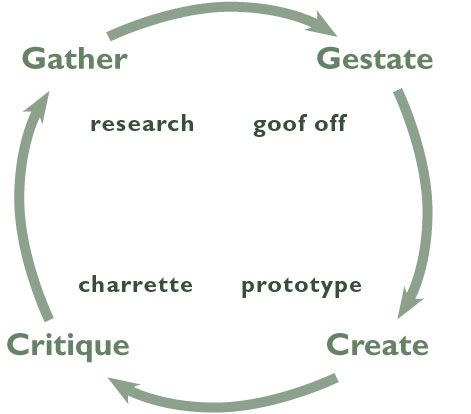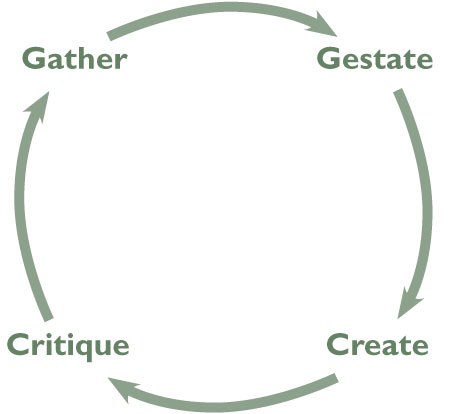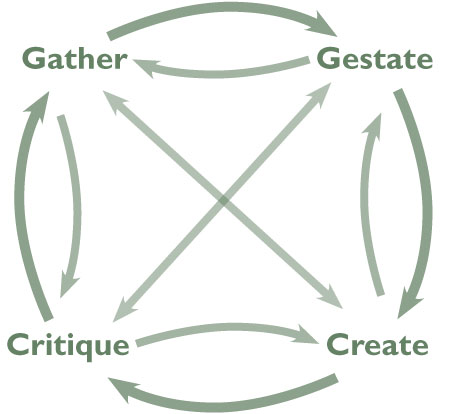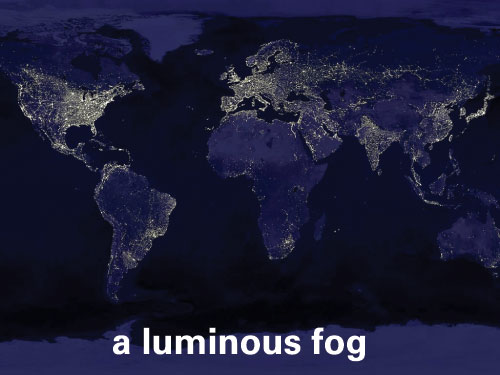
1. The Night Sky
Mankind is proceeding to envelope itself in a luminous fog
– Italian astronomer Pierantonio Cinzano
Kipple drives out nonkipple… No one can win against kipple, except temporarily and maybe in one spot.
– Do Androids Dream of Electric Sheep? Philip K. Dick, 1968
(via 43 folders)
Pierantonio Cinzano’s 2001 atlas of artificial night sky brightness estimated that two-thirds of the U.S. population, and one-fifth of the world population, can no longer see the Milky Way with the naked eye.
Perhaps Cinzano’s luminous fog has been transported into our minds. In the connected world there is a wealth of information and a dearth of wisdom. In my own life I resist, more or less successfully, attraction and distraction from the latest email or blog or website or television show or other diversions, always rushing from virtual place-to-place, willy-nilly and busy-busy.
What is this luminous fog? The extraneous, the kipple (as described by Philip K. Dick), the extra bits of detritus that pile up and distract us from what matters. All those ways of filling the day, so much to be done, so many avenues to explore.
But how to keep the current in perspective with the important? How to balance the emerging with the essential? Which is kipple and which nonkipple? With limited time and energy, something has to go, and soon enough the latest episode of Project Runway replaces Ovid’s Metamorphoses. Soon enough the ephemeral stars of hollywood replace the dimming stars in the night sky.
2. The Daily News
I read the news most every morning. My newspapers come from all over the world, and are neatly segmented by my RSS news reader, netnewswire, into various categories. I get the headlines from the New York Times, and the BBC, and El Pais. I get design news from Core 77 and Unbeige, and Swiss Miss, and Web 2.0 updates from techcrunch and techmeme and boing boing and wired. Environmental news comes from worldchanging and open the future, words from the virtual thesaurus, and local info from denver infill and coloradopols.com and westword. And that’s only the beginning.
It comes through email too; I get news stories sent to me from friends and acquaintances; this past week Tim Roessler sent me a link about John Thackera, director of Doors of Perception. Mike Reddick sent a note about Open ID. Ed Hickok sent a news item on how kangaroo farts may help with global warming. All great news stories.
I have a friend, David Callaway, who is managing editor for Marketwatch.com, the online financial news service. Recently he wrote a column marking the tenth anniversary of Marketwatch where he argued that “Content isn’t king. News is king.†It may be king. But is it enough?
When I posed the question of of timeliness to a panel of design bloggers, including Alissa Walker of unbeige and Allan Chocinov of Core 77, at the AIGA Next conference in October, both Alissa and Allan stated their desire to be first, to get the scoop. As Liz Danzico said in her notes posted on unbeige, “if a day goes by, the topic is gone. So timing is everything.â€
Absolutely vital and correct, if you’re in the news business, and perhaps if you are in the business of tracking the industry full-time. But for a casual reader seeking insights into what matters in the our world, it’s simply overwhelming. The pink noise of our environment drowns out all perspective.
Sure, RSS feeds offer some control, but what can be done about people like Tina at swissmiss or the crew at joshspear? These people are insane with all their postings. Clearly they is trying to ruin my life, condemning me to do nothing but click through a relentlessly updated directory of beautiful distractions. Something must be done.
3. Terminally Hip
The truth is that I really like staying up on what’s happening. I’m definitely not as hip as I was when I was younger – I like to think that the perspective of age offers some buffer to the slower synapses that accompany it – but I’m still reading and listening to music and following the arts and learning to use technology. This is a great world for the curious, but a confusing one too.
Our connected world provides a virtually unlimited number of information sources, and each has the potential to lead to any number of detours and distractions. Without self-discipline, days go by, and months, without measurable progress. Without clear focus, life devolves into little more than survival and self-deception.
Moments of self-awareness, and the discipline and drive that come with them, are followed by a confusing array of stimuli, carefully arranged to provide the delusion of progress. Meetings and emails and the last episode of extras and here comes another technical innovation or gadget or object or bit of news, perhaps containing a nugget of truth, with anxiety inducing consequences. What if I miss the next big thing? What if there is a wave coming, a tsunami, and this particular bit is its harbinger?
4. Something Must Be Done
The biggest question then, is how to prioritize without turning into some kind of militaristic asshole (with all due respect to the militaristic assholes out there). First of all, there have to be limits. And there has to be some sort of time management. So, here’s the plan:
I am working toward (but have not yet achieved) an empty email inbox (or inbox zero as they call it at 43 folders. In a perfect world, each email is looked at exactly once, then acted upon (responded to, filed, or deleted). Just like in the old days with real mail. Also, I’ve switched from checking email every ten minutes to every half an hour (though I sometimes check in between), and I sometimes turn off email when I’m working on a project. Currently I’m at 73 emails in my inbox. Hey, it’s progress.
News, blogs, RSS feeds, and the like are only checked at prescribed times during the day (first thing in the morning, with coffee), and meetings are only used when necessary (lunch). Objectives are prioritized, and what has to be done gets done (more or less) based on this plan. Meetings are designed for efficiency, and work is structured to allow for clear delineation between different projects. Feedback loops are encouraged, and iterative modeling and prototyping are applied with dizzying effect.
At least that’s the plan.
5. Learning to Listen
A little over a year ago on this site I mentioned a story I’d heard about Norman Schwarzkopf and how he handled time management. His approach focused on achieving the single most important thing he had to get done each day – after that everything else fell in place. There’s something to that idea, but it’s just one part of the puzzle.
In the past year I’ve posted about 90 articles on this site, roughly one every 4 days or so. Some are brief, some more considered. Some that I would have liked to have posted have disappeared from memory, and there are some that I wish I hadn’t wasted the bandwidth on. I’ve tried to be respectful in what I post, not adding to the noise of the world. It’s one person’s perspective, but at least it’s measured.
For me, seeing through the luminous fog has more to do with listening than talking. Taking the time not to rush through the day, really spending the time understanding an idea deeply, less quantity and more quality. The breathing, the stretching, the awareness of space and time.
It’s not the four hour work week, but it’s a start.
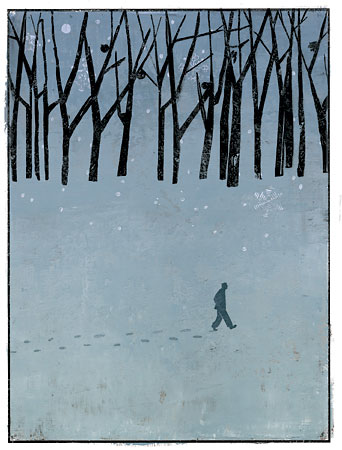


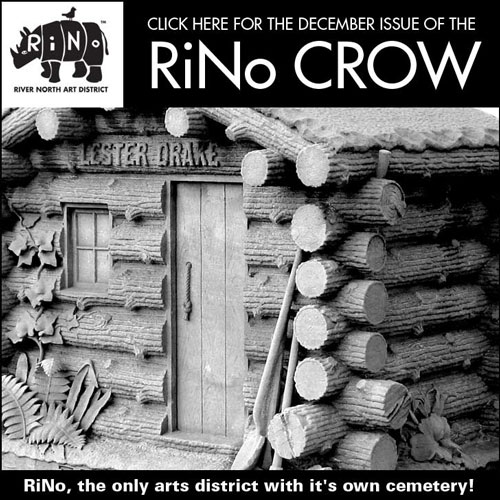
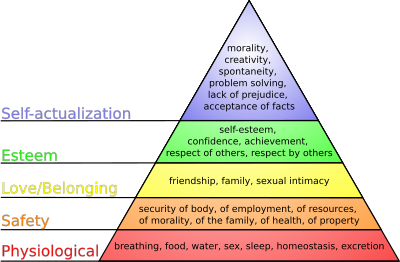
 Similarly, mobile email wasn’t something that the students used on a regular basis. Unlike business users (like myself), with our addiction to our ‘crackberries’, the immediate access to email isn’t that important to students. They are okay with accessing their email via their laptop, and if they don’t get an email message immediately it’s not a cause for concern. Usually they check their email (often through a web browser) as they’re getting into their work process. Check email, check a couple of news sites, and then settle in to do your homework.
Similarly, mobile email wasn’t something that the students used on a regular basis. Unlike business users (like myself), with our addiction to our ‘crackberries’, the immediate access to email isn’t that important to students. They are okay with accessing their email via their laptop, and if they don’t get an email message immediately it’s not a cause for concern. Usually they check their email (often through a web browser) as they’re getting into their work process. Check email, check a couple of news sites, and then settle in to do your homework. 
 When I was nine or ten years old, I used to watch the
When I was nine or ten years old, I used to watch the 